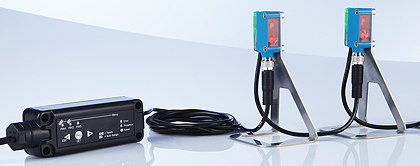- Home » News » Technology News
Flexible chain concept marks a ‘paradigm shift’ in light grids

The German sensor-maker Sick claims to have reinvented the industrial light grid with a flexible system consisting of up to 60 individual beams that are daisy-chained to each other and controlled by a single host. Unlike traditional rigid profiles with fixed send and receive modules, the transmitters and receivers in the new FlexChain system can be positioned flexibly with different photoelectric sensing technologies – through-beam, retro-reflective and proximity – being mixed freely to suit an application.
Sick unveiled the new system – claimed to be the first of type – at the recent SPS IPC Drives exhibition in Germany. It says that the system represents a paradigm shift in how automation light grids are designed and used.
Cascading the sensors in a “light chain” connected to a compact central host minimises cabling costs. Detailed real-time diagnostic information on the status of each sensor can be evaluated in the host, or forwarded to other systems via IO-Link. This is said to ensure maximum detection reliability and measurement certainty.
The sensors are cabled as a cascade using pigtails in customisable lengths, making installation easier than individually wired photoelectric sensors and simplifying the process of integrating the sensors into a plant. It is easy to add more sensors at a later stage.
The FlexChain host has a CANopen fieldbus interface, an RS-485 port, and an IO-Link connection for integrating it with machines or plant controls.
The system operates like a light grid. Its detection reliability is not affected by how the sensors are arranged or how far away they are from each other. The individual beams cycle sequentially at a rate of 200µs, preventing them from interfering with each other and sensor signals from being superimposed, even if the optical modules are mounted close together.

Unlike conventional light grids, the sensors are positioned individually, making it possible to vary the beam separation to suit the application. Measuring ranges and detection zones of different widths can be set up within a task.
Users are free to choose the best detection principle for their application. The sensors are based on Sick’s G6 family and are fitted with special ASICs (custom chips) for the flexible light grid version.
The FlexChain light grid is commissioned via a two-button display on the host module. All of the connected sensors are identified, addressed, and taught-in automatically at the touch of a button. It is also possible to configure application-specific logic in the host. Customised parameterisation can be performed via USB.
Real-time diagnostic options include the degree of contamination of individual sensors, and communication performance. Potential faults can be detected early to avoid failures and downtime.
Sick says that no other automation light grid currently available offers more freedom than FlexChain in terms of design or installation.





